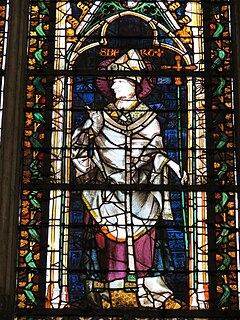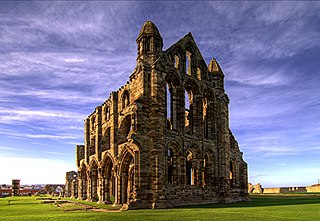Notes
- ↑ Saint Begu of Hackness at Saints.SQPN.com
- 1 2 Farmer, David (1992).Oxford Dictionary of Saints Oxford. p.44.
- 1 2 "Britannia.com". Archived from the original on 2010-01-31. Retrieved 2008-02-03.
Begu | |
|---|---|
| Nun | |
| Born | Hackness, Yorkshire |
| Died | 31 October 690 |
| Venerated in | Roman Catholicism |
| Feast | 31 October [1] |
Saint Begu (died 31 October 690) was a nun and later became a saint from Hackness, Yorkshire (Deira). [2] She served at the monastic cell in the nunnery of Hackness, near Scarborough which was built by St Hilda of Whitby shortly before her death.
Begu was the woman who claimed to have witnessed Hilda's soul being borne to heaven by angels when Hilda died on 17 November 680. Tradition states that at the moment of Hilda's passing, the bells tolled. Begu awoke to find her fellow sisters in the dormitory sleeping; it is then that Begu stated she witnessed the vision of the roof of the house opening and Hilda's soul been borne into heaven. The nuns awakened and prayed for the soul of the blessed abbess until, at dawn, some monks arrived to tell them of her death. [3]
Years after the death of Begu herself, the monks of Whitby Abbey were seeking holy relics to replace those of Hilda in 1125, [2] as they were transferred to Glastonbury Abbey due to the 10th century Viking raids. Through a supposed revelation, a sarcophagus was uncovered at Hackness where Begu had served; it bore the inscription Hoc est sepulchrum Begu, the contents were transferred to nearby Whitby where miracles were soon reported. [3]

Cædmon is the earliest English poet whose name is known. A Northumbrian who cared for the animals at the double monastery of Streonæshalch during the abbacy of St. Hilda, he was originally ignorant of "the art of song" but learned to compose one night in the course of a dream, according to the 8th-century historian Bede. He later became a zealous monk and an accomplished and inspirational Christian poet.
Eanflæd was a Deiran princess, queen of Northumbria and later, the abbess of an influential Christian monastery in Whitby, England. She was the daughter of King Edwin of Northumbria and Æthelburg, who in turn was the daughter of King Æthelberht of Kent. In or shortly after 642 Eanflæd became the second wife of King Oswiu of Northumbria. After Oswiu's death in 670, she retired to Whitby Abbey, which had been founded by Hilda of Whitby. Eanflæd became the abbess around 680 and remained there until her death. The monastery had strong association with members of the Northumbrian royal family and played an important role in the establishment of Roman Christianity in England.
Paulinus was a Roman missionary and the first Bishop of York. A member of the Gregorian mission sent in 601 by Pope Gregory I to Christianize the Anglo-Saxons from their native Anglo-Saxon paganism, Paulinus arrived in England by 604 with the second missionary group. Little is known of Paulinus's activities in the following two decades.

Whitby Abbey was a 7th-century Christian monastery that later became a Benedictine abbey. The abbey church was situated overlooking the North Sea on the East Cliff above Whitby in North Yorkshire, England, a centre of the medieval Northumbrian kingdom. The abbey and its possessions were confiscated by the crown under Henry VIII during the Dissolution of the Monasteries between 1536 and 1545.

The Monk: A Romance is a Gothic novel by Matthew Gregory Lewis, published in 1796. A quickly written book from early in Lewis's career, it was published before he turned twenty. It is a prime example of the male Gothic that specialises in the aspect of horror. Its convoluted and scandalous plot has made it one of the most important Gothic novels of its time, often imitated and adapted for the stage and the screen.

Hilda of Whitby or Hild of Whitby is a Christian saint and the founding abbess of the monastery at Whitby, which was chosen as the venue for the Synod of Whitby. An important figure in the Christianisation of Anglo-Saxon England, she was abbess at several monasteries and recognised for the wisdom that drew kings to her for advice.

Saint Kenelm was an Anglo-Saxon saint, venerated throughout medieval England, and mentioned in the Canterbury Tales. William of Malmesbury, writing in the 12th century, recounted that "there was no place in England to which more pilgrims travelled than to Winchcombe on Kenelm's feast day".
A double monastery is a monastery combining separate communities of monks and of nuns, joined in one institution to share one church and other facilities. The practice is believed to have started in the East at the dawn of monasticism. It is considered more common in the monasticism of Eastern Christianity, where it is traceable to the 4th century. In the West the establishment of double monasteries became popular after Columbanus and sprang up in Gaul and in Anglo-Saxon England. Double monasteries were forbidden by the Second Council of Nicaea in 787, though it took many years for the decree to be enforced. In a significantly different way, double monasteries were revived again after the 12th century, when a number of religious houses were established on this pattern, among Benedictines and possibly the Dominicans. The 14th-century Bridgittines were purposely founded using this form of community.

Leoba was an Anglo-Saxon Benedictine nun and is recognized as a saint. In 746 she and others left Wimborne Minster in Dorset to join her kinsman Boniface in his mission to the German people. She was a learned woman and was involved in the foundation of nunneries in Kitzingen and Ochsenfurt. She had a leading role in evangelizing the area. Leoba was acclaimed for many miracles: saving a village from fire; saving a town from a terrible storm; protecting the reputation of the nuns in her convent; and saving the life of a fellow nun who was gravely ill – all accomplished through prayer.

Saint Edith of Wilton was an English nun, a daughter of Edgar the Peaceful, king of England. She was born between 961 and 964 and died on 16 September in a year between 984 and 987. Following her death in 984, she became the patron saint of her community at Wilton Abbey in Wiltshire and churches were dedicated to her in Wiltshire and in other parts of Anglo-Saxon England. Her biography was written by Goscelin and her feast day is on 16 September.
Bosa was an Anglo-Saxon Bishop of York during the 7th and early 8th centuries. He was educated at Whitby Abbey, where he became a monk. Following Wilfrid's removal from York in 678 the diocese was divided into three, leaving a greatly reduced see of York, to which Bosa was appointed bishop. He was himself removed in 687 and replaced by Wilfrid, but in 691 Wilfrid was once more ejected and Bosa returned to the see. He died in about 705, and subsequently appears as a saint in an 8th-century liturgical calendar.

Seaxburh, also Saint Sexburga of Ely was a Queen as well as an abbess, and is a saint of the Christian Church. She was married to King Eorcenberht of Kent.

Ansbert, sometimes called Ansbert of Chaussy, was a Frankish monk, abbot and bishop of Rouen, today regarded as a saint in the Catholic Church.
Itta of Metz, O.S.B. was the wife of Pepin of Landen, Mayor of the Palace of the Kingdom of Austrasia. After his death, she founded the Abbey of Nivelles, where she became a Colombanian nun along with her daughter, Gertrude of Nivelles. Both are honored as saints by the Catholic Church.

Saint Bega was reputedly a saint of the Early Middle Ages; an Irish princess who valued virginity. Promised in marriage to a Viking prince who, according to a medieval manuscript The Life of St Bega, was "son of the king of Norway", Bega "fled across the Irish sea to land at St. Bees on the Cumbrian coast. There she settled for a time, leading a life of exemplary piety, then, fearing the raids of pirates which were starting along the coast, she moved over to Northumbria". The most likely time for this would have been after AD 850, when the Vikings were settling Ireland.

Saint Ælfflæd (654–714) was the daughter of King Oswiu of Northumbria and Eanflæd. She was abbess of Whitby Abbey, an abbey of nuns that were known for their skills in medicine, from the death of her kinswoman Hilda in 680, first jointly with her mother, then alone. Ælfflæd was particularly known for her skills in surgery and her personal attention to patients, as was Hilda, who was known for her personalized medical care.

Hartlepool Abbey, also known as Heretu Abbey, Hereteu Abbey, Heorthu Abbey or Herutey Abbey, was a Northumbrian monastery founded in 640 CE by Hieu, the first of the saintly recluses of Northumbria, and Aidan of Lindisfarne, on the Headland Estate of Hartlepool now called the Heugh or Old Hartlepool, in County Durham, England.
Kyneburga, Kyneswide and Tibba were female members of the Mercian royal family in 7th century England who were venerated as saints.
Dom Bede Camm, O.S.B., (1864-1942) was an English Benedictine monk and martyrologist. He is best known for his many works on the English Catholic martyrs, which helped to keep their memories alive in the newly reemerging Catholic Church of Victorian England.

Hildelith of Barking, also known as Hildilid or Hildelitha, was an 8th-century Christian saint, from Anglo-Saxon England but of foreign origin.